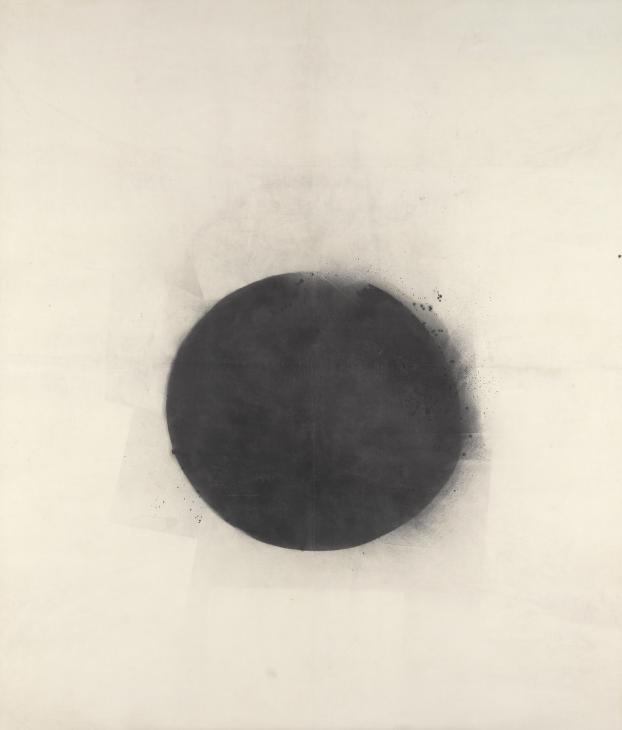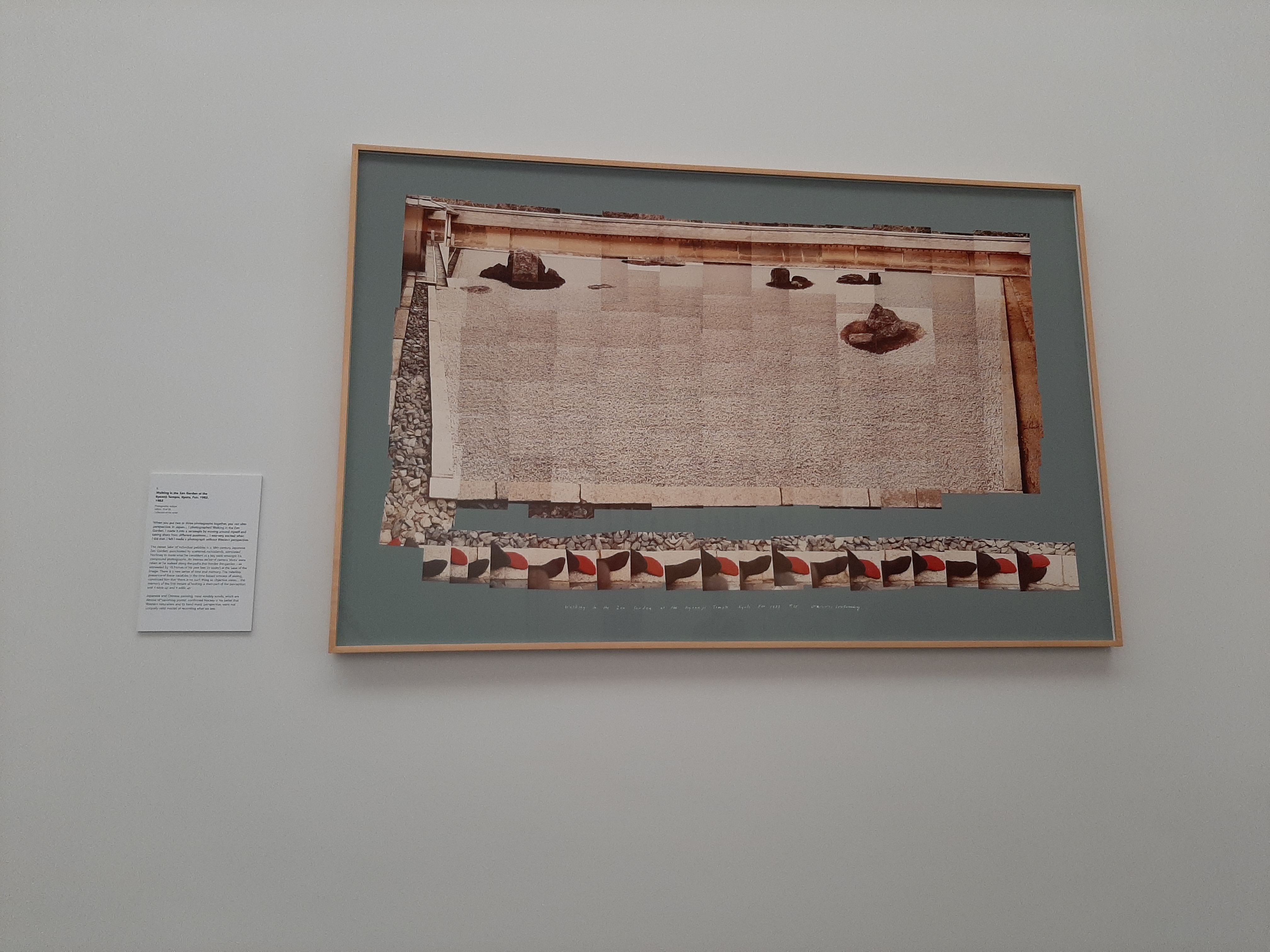We live in a world surrounded by culture and, in turn, art. Art can be found in galleries and museums, on the walls of streets and, arguably, walking the streets in the form of people's fashion choices. When art in the contemporary world can be seen to have strayed so far from its "traditional" vision (e.g. fine art paintings), I find it increasingly interesting to see just how far the art world is willing to push the boundaries of what it includes.
This intrigue led me to John Latham's 'Full Stop' (1961): the muse behind this blog. Latham's piece consists of what appears to be a large centralised black dot or hole painted onto an otherwise vacant canvas. According to Latham himself, one of the intentions behind the piece was to illustrate 'a new way of understanding time and matter' by showing a collection of particles compacted together in the form of a solidified dot. The particle element stems from how the overall dot was painted using an acrylic paint spray gun, causing the dot not to have entirely clean edges.
 Photo Credit: https://www.tate.org.uk/art/artworks/latham-full-stop-t11968
Photo Credit: https://www.tate.org.uk/art/artworks/latham-full-stop-t11968
For the average art viewer, I doubt this interpretation is the first that comes to mind upon seeing Latham's Full Stop. Art, in what it encompasses as an umbrella term and its interpretative nature, is highly subjective. So, in the spirit of subjectivity, I decided to ask an assortment of people what they thought of Latham's piece. What does Full Stop mean to them, and, most importantly, does it count as "art"?
When showing the participants this piece, I did not give them any details aside from the image itself to ensure that nothing was present that could influence their thoughts. They did not get access to the name of the piece for this reason either.
What does this piece mean to you? How do you interpret this piece?
'The painting appears similar to the interpretation of a black hole, and I really like the subtle smudges around the edge. It makes the image appear almost 3D.' (Gabs, 21, Media & Communications BA Student).
'Honestly, nothing really. There aren't many emotions that are called up by a black circle. There are things that it reminds me of if I were to think about it, such as sun spots or a black hole, but it doesn't open the conversation about those things. The art itself doesn't speak to me nor evoke any kind of emotion. However, with pieces like this, the art comes with a message that is more important than the piece itself. Maybe if I'd known the message of the piece or the journey that the artist had taken to create this, it would speak to me, but on its own, this work doesn't do it for me.' (Adam, 22, former Art Student & Technician).
'If I see it in my imagination, it looks like a moon. Sometimes it also looks like a ball thrown into a tub of water, and it's slowly bursting its colour into the water.' (Nusrat, 23, Language & Linguistics BA Student).
'Are you looking into a well or out of one? How deep is it? Infinite depth? Maybe it's a black hole in space, but which side of it are you on? Are you looking in or out?' (Michael, 65, Retired Signwriter).
Does Full Stop count as “art”?
'I definitely think it counts as art. It's a published piece with the (appeared?) intention of evoking a response and interpretation. I viewed it as metaphorical for a black hole, a seemingly endless hole caving in on itself, which I feel is captured well in the image. Others might interpret it differently, and I think this is important in an art piece - to evoke different feelings and potentially different interpretations.' (Gabs, 21, Media & Communications BA Student).
Regardless of my opinion, it is art. The very nature of art means that almost anything can be art, and abstract art is one of the most broad in terms of what qualifies. To not be art, a piece has to be explicit in its lack of message and intention for it to be art, and while I don't know the message, the intention is there, and that's all that matters for it to be art.' (Adam, 22, former Art Student & Technician).
'It isn't art because it is just a circle with some hand smudges. According to me, art is a portrait of something or someone, such as a painting.' (Nusrat, 23, Language & Linguistics BA Student).
'I guess it's art because anything can be considered as art if someone says/thinks it is now.' (Marc, 24, Computing Student).
'It's art! It raises questions. It is what you make of it. If I saw it in an art gallery, I would put one word under it: 'Infinity'!' (Michael, 65, Retired Signwriter).
From the array of responses gathered, the subjective nature of abstract art is clear. Everyone had something different to say about the piece, regardless of whether they thought that Full Stop counted as "art" or not. These responses succeeded in raising another important question that one may consider as well: what DOES make a piece count as art, irrespective of the term's subjectivity? Is something art if it's published or in a gallery? Is it art if it is made by somebody well known and established in the art world? If so, how does a new artist break into the scene through abstract art?
In the case of abstract art, it at least appears that it holds no immediate expectation but rather the possibility for us as a viewer to develop our own answers. As someone who has recently visited many galleries, thinking deeply into the likes of Latham's work provided me with a different perspective on what art can be when viewed. If a piece of work appears more simplistic, I feel people are quicker to write off its potential for being "art", as it looks "easy" to make upon looking at it. However, in most cases, simplistic works in a display often hold an abundant process of thought and journey that remains invisible on the canvas.
I recently visited Downing College's Heong Gallery in Cambridge to view some of the Hockney Eye exhibition currently occupying several spaces around the city. There were a number of pieces, such as one depicting a Japanese rock garden, which appeared simpler than other works at first glance. However, when focusing on the details more carefully, such as the cleverness of compiling numerous digital photos together to create the vision of someone walking by a gravel path, it's impossible to deny that the piece isn't well thought out in terms of production. Whether a viewer believes that the piece is "art" or not, this fact remains.

Rock Garden photo, taken during my gallery visit.
From what a piece means to whether a piece even counts as "art", the subjectivity of abstract art will always be left open for debate. Sometimes, pausing to think to yourself why somebody may have been inspired enough to want to bring that idea into the world can be the difference between understanding the gravity the creator thinks it holds or writing it off completely.









0 Comments